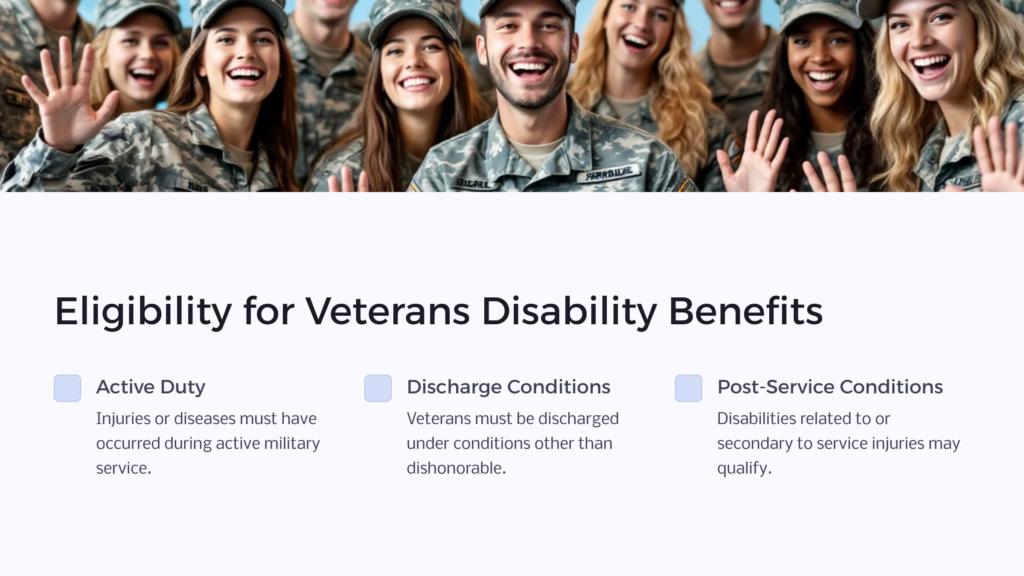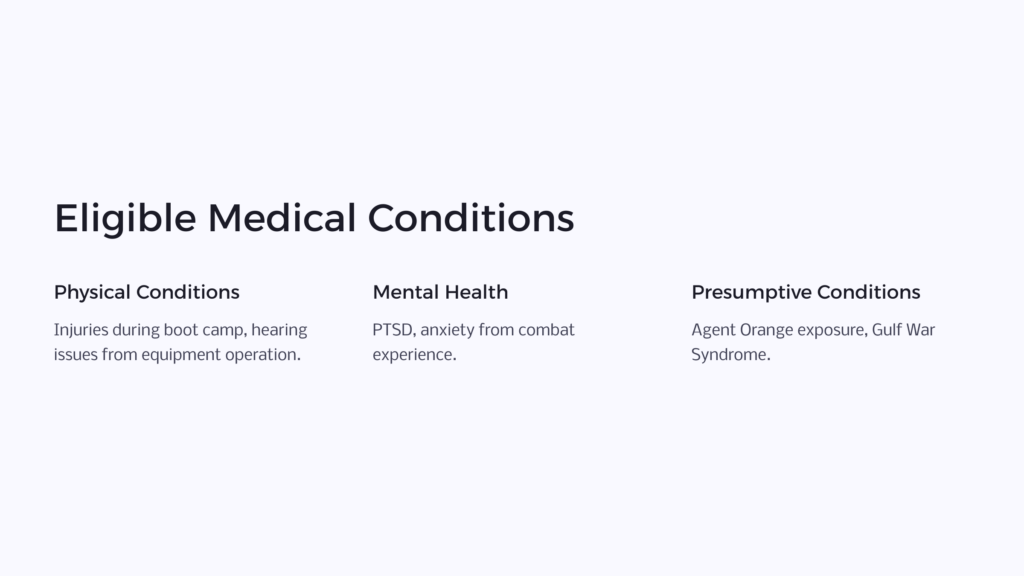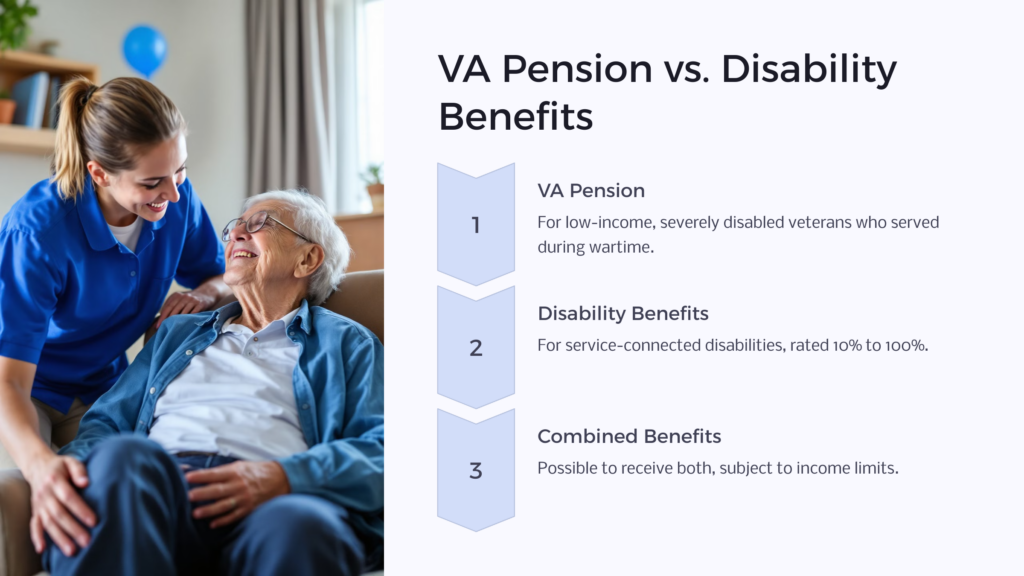Veterans’ are entitled to compensation for disability from an injury or disease that occurred (or was aggravated) during active military service. This applies to partial or full disability, on a scale from 10% – 100% disabled, depending on how much the condition interferes with your normal life functions.
Type of military service

In order to qualify for veterans disability benefits, your injuries or diseases need to have occurred or been aggravated, during active military service, defined as:
- active duty, OR
- active duty for training, OR
- inactive duty training.
Eligible veterans need to have been discharged or released “under conditions other than dishonorable.” Veterans may also receive disability compensation for disabilities or diseases that occurred after service — if they can be shown to be related to, or secondary to, injuries or exposures that occurred during service.
Eligible medical conditions

Disability payments can be made for both physical and mental health conditions. Two examples provided on the U.S. Department of Veterans Affairs website are:
- A reservist who injures her knee during physical training – she is entitled to compensation for residual problems from the knee injury.
- A veteran who served for three years in the Navy, fell and injured his back during active duty — after being honorably discharged, he is entitled to disability benefits for residuals from his back injury.
Compensation is available for a wide range of physical and emotional conditions. These include injuries during boot camp, ringing in the ears from driving a tank, or anxiety from combat experience. Claims and benefits are increasing for PTSD (post-traumatic stress disorder) – the most common mental health disorder from combat.
Certain disabilities are presumed to stem from specific periods of military service. For example, the VA now acknowledges that Agent Orange exposure has caused many illnesses in vets who were exposed. Veterans who served in Vietnam or areas of Korea during certain periods are presumed to have been exposed and may be eligible for payments If they have current ailments related to Agent Orange. Also, veterans suffering from exposure to other hazardous chemicals or Gulf War veterans who experience symptoms of “Gulf War Syndrome” may also qualify for compensation.
TBI and Diabetes among conditions now recognized
Veterans who suffer effects from Traumatic Brain Injuries (TBI) are now more likely to get assistance from the VA. Vets from Irag and Afghanistan are showing a high rate of TBI injuries and related symptoms – so much so that the VA announced a new system to review claims. Certain vets who filed earlier TBI claims and were denied can have their claims reprocessed.
Diabetes mellitus (Type II) has now been officially linked to Agent Orange exposure. In some cases, retroactive awards can be granted for Vietnam vets who applied for service-connection to diabetes before 2001 and were denied.
Often it takes the VA years to acknowledge a military connection to ailments that veterans suffer. Experts say the best thing to do is file a claim and list all of your symptoms. Also get free help from Veterans Service Organizations who have trained staff to help you get the compensation you deserve.
Benefits available
If you are found to have an eligible condition stemming from military service, you will be rated on a scale from 0 – 100% disabled. If you are at least 10% disabled, you will receive a monthly tax-free payment. The base monthly veterans disability benefit currently listed for 100% disability is $2916 for a veteran with no dependents. From this base payment, additional benefits can be available, such as:
- Additional compensation is paid out for dependents, which can rise to a total of $$3,187 monthly for full disability for a veteran with one spouse and one child.
- For certain conditions requiring the need for aid and attendance, an additional Special Monthly Compensation may be available.
- Other benefits – Once disability is established, funds may be available for other types of assistance, such as an automobile allowance, clothing allowance, convalescence, dental, etc.
Be sure to find out all you’re eligible for. There are no age or income requirements to receive benefits, and you can still work if you’re able.
Administration of Benefits
The U.S. Department of Veterans’ Affairs administers health benefits to veterans. The VA is the second largest federal agency, next to the Department of Defense. It has two separate health-related divisions:
- The Veterans Health Administration (VHA) runs the VA medical centers and provides healthcare to veterans. It does not run the disability benefits program.
- Veterans Benefits Administration – The Veterans Benefits Administration (VBA) processes applications for veterans disability benefits.
Usually, the two departments have offices in entirely separate facilities and are run separately. For example, a VHA doctor may be treating your service-related condition, but you are not technically a “disabled veteran” until you apply and are approved by the Veterans Benefits Administration.
There are many flaws in the application processing system, including long delays and very high error rates. See our articles for more details on how to apply for Veterans disability benefits:

VA Pension & VA disability benefits
 Veterans may wonder if they can receive both pension payments and VA disability benefits. The answer is yes, you might be able to participate in both programs – but it depends on the amount of your disability benefits. It may help to review the different purposes and eligibility requirements for each benefit:
Veterans may wonder if they can receive both pension payments and VA disability benefits. The answer is yes, you might be able to participate in both programs – but it depends on the amount of your disability benefits. It may help to review the different purposes and eligibility requirements for each benefit:
Non-service-connected pension benefits for veterans disabled after service
This type of pension is not for any service-connected disability. It is designed for veterans who become disabled from conditions that occurred after their military service. It is intended for:
- Low income veterans, who meet income requirements, AND
- Who are severely disabled, AND
- Who served during a federally recognized time of war, AND
- Who were discharged under other than dishonorable conditions.
To receive these benefits, the veteran must be permanently and totally disabled, and generally unable to work. The income levels are quite low to qualify. Your yearly family income must be less than the amount set by Congress to qualify for the Veterans Pension benefit. For example, as of December 1, 2012, the cap on income for veterans with no dependents was $12,465 per year. If your countable income is more than that, you do not qualify. If your countable annual income is less than that, then you would be paid the difference to bring your total income to the $12,465 amount. For example, if your countable annual income was $10,000, you would be paid $2,465 in 12 monthly payments.
VA disability benefits
Disability compensation is designed for veterans whose disabling illness or injury is connected to, or aggravated by, their military service. The benefit is paid on a scale from 10% disability to 100% disability. So veterans who are only partially disabled can still receive some benefits under this program.
There is no income test or requirements to receive disability benefits. To be eligible, veterans must have been discharged under other than dishonorable conditions.
Receiving both pension and disability payments
Veterans can receive both non-service connected pension and service-connected disability benefits — if the amount they receive in disability payments, and from other income sources, is less than their pension income cap.
In this way, veteran’s disability payments are counted as an income source. For example, for a veteran with no benefits, the pension income cap is currently $12,465 per year. If that pensioner is also awarded a disability benefit, s/he can receive all or part of the benefits, so long as that doesn’t cause the total annual income to go over $12,465.
Waiting for Veteran Disability Benefits – How long does it take?
Learn what you can do to get a faster decision on your Veteran Disability Benefits claim, how to avoid delays in getting medical records, and how the Fully Developed Claim program can speed the process.
It has become a well-known fact that the VA can take a long time to process claims for Veteran Disability Benefits. The good news is that the VA has reduced the average amount of time it takes to get a decision on a claim. In 2016, a veteran waited an average of 123 days to hear the results of a claim, way down from the eight-month wait in 2012 and the nearly one-year average wait in 2013.
The bad news is, there still can be lengthy delays and the time varies considerably by the location where you file.
Increased media and political attention
Increased media and political scrutiny have prompted calls for improvement. In 2012, a report from the Center for Investigative Reporting publicized the shameful delays that the VA was subjecting disabled veterans to. Even then, the problem got worse before it slowly got better. For its part, the VA pointed to the ballooning number of claims from Afghanistan and Iraq vets, on top of vets from the Vietnam War era who are filling new claims.
Current VA policy states that it aims to issue a decision on a claim within 125 days of submission. Any claim taking longer than 125 days for a decision is considered to be “backlogged.”
In 2013, the VA backlog peaked at 611,000 claims sitting longer than 125 days for a decision. By 2015, the backlog was down to less than 100,000 claims. Today, about 70-80,000 claims are backlogged.
Wait time varies by region
The VA has created a National Work Queue process that’s intended to even out some of the varied wait times by region. However, in practice, regions still vary considerably.
According to data tracked by the Center for Investigative Reporting, in 2015, the average wait time for a claim decision was as high as 149 days in Baltimore, 146 days in Reno, and 139 days in Chicago; while the average wait was only 127 days in Indianapolis and Boston, and only 108 days in Phoenix.
Gathering medical records can cause delays
Some delays can be caused by problems the VA has in sharing medical records with the DOD and medical providers. The VA is also trying to streamline the use of electronic records sharing between the parties involved in establishing a veteran’s claim. In these cases, vets can help obtain any records themselves, or to be sure to start the process right away. It might be faster for you to just obtain certified paper records yourself, if that’s possible for what you need.
What can you do?
While some of the delay problems may be out of your control, you can still do everything you possibly can to speed up the process from your end. When you apply, secure all of the required evidence in the desired format. Check and double-check that any records you request are sent and received where they need to be. Continually follow-up with your doctor’s office and the VA, and your agent, if you have one, to make sure everything is moving along with your application.
The VA has created a Fully Developed Claim program that can allow you to speed up the time it takes to process your claim for veterans disability benefits. The program helps guide you on how to provide all of the relevant information in precisely the correct form that the VA needs to process it. You do your part by getting hold of the necessary records yourself and sending them to the VA. This can expedite the evaluation of your claim. If you file a Standard Claim, the VA is responsible for getting relevant documents and this can cause delays.
The VA encourages veterans to take advantage of assistance in filing their claims. It is very important that you do everything you can to file a complete application. If there is an error or missing information that leads to an initial denial, appeals can take even longer. Some vets who appeal a denied claim can years for a resolution.
The best you can do in the face of inevitable delays is to stay on top of your claim at all times and get qualified assistance.
 Benefits.com Advisors
Benefits.com Advisors
With expertise spanning local, state, and federal benefit programs, our team is dedicated to guiding individuals towards the perfect program tailored to their unique circumstances.
Rise to the top with Peak Benefits!
Join our Peak Benefits Newsletter for the latest news, resources, and offers on all things government benefits.


















